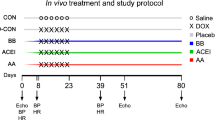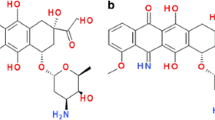Abstract
Childhood survivors of cancer who are treated with anthacycline chemotherapy, such as doxorubicin (DOX), can develop late-onset cardiomyopathy years after chemotherapy. The mechanism(s) for progression of anthracycline cardiotoxicity to late cardiomyopathy is unknown. Because angiotensin II has been implicated in the progression of other cardiomyopathies, this investigation was undertaken to determine whether treatment with an angiotensin-converting enzyme (ACE) inhibitor, lisinopril, reduces the time-dependent effects of doxorubicin on cardiac gene expression and myocellular apoptosis. A single dose of saline (control) or doxorubicin (DOX treated; 2 mg/kg iv) was administered to rabbits. Control and DOX-treated groups were also subgrouped to receive lisinopril and designated as lisinopril or DOX+lisinopril, respectively (1 mg/kg/d oral), for 10 wk. Histopathology, as determined at the light and ultrastructural level, was consistent with a reduced number of cardiomyocytes relative to interstitial cells in the left ventricle (LV) of the DOX-treated group compared with control and DOX+lisinopril groups. Gene expression of the pro-atrial naturetic peptide (NAP), quantified by steady-state messenger ribonucleic acid (mRNA) levels with reverse transcriptase polymerase chain reaction (RT-PCR) and Southern blotting, increased approx 12-fold (n=10; p<0.05) in the LV of DOX-treated groups compared to control and DOX+lisinopril groups. Increased ANP mRNA expression following doxorubicin dosing was localized predominantly in ventricular myocytes by in situ hybridization. Deoxyribonucleic acid (DNA) fragmentation, determined by TUNEL (terminal deoxynucleotidyl transferase-mediated dUTP nick-end labeling), was increased in both DOX-treated and DOX+lisinopril groups compared to the control group. Lisinopril prevented both late-onset increased ventricular ANP expression and subsequent DOX-induced myocyte loss. The authors speculate that these protective effects of lisinopril are related to reduced ANP expression and myocyte loss, the latter possibly mediated by effects on myocellular apoptosis.
Similar content being viewed by others
References
Singal, P.K. and Iliskovic, N. (1998). Doxorubicin-induced cardiomyopathy. N. Engl. J. Med. 339:900–905.
Boucek, R.J. (1998). Mechanisms for anthracycline-induced cardiomyopathy: clinical and laboratory correlations. Prog. Pediatr. Cardio. 8:59–70.
Iarussi, D, Indolfi, P., Galderisi, M., and Bossone, E. (2000). Cardiactoxicity after anthracycline chemotherapy in childhood. Hez. 25:676–688.
Steinherz, L.J., Steinherz, P.G., Tan, C.T., Heller, G., and Murphy, M.L. (1991). Cardiac toxicity 4 to 20 years after completing anthracycline therapy. JAMA 266:1672–1677.
Lipshultz, S., Colan, S., Gelber, R., Perez-Atayde, A., Sallan, S., and Sanders, S. (1991). Late cardiac effects of doxorubicin therapy for acute lymphoblastic leukemia in chidhood [see comments]. N. Engl. J. Med. 324:808–815.
Steinherz, L.J., Steinher, P.G., and Tan, C. (1995). Cardiac failure and dysrhythmias 6–19 years after anthracycline therapy: a series of 15 patients. Med. Pediatr. Oncol. 24:352–361.
Nysom, K., Colan, S.D., and Lipshiltz, S.E. (1998). Late cardiotoxicity following anthracycline therapy for childhood cancer. Prog. Pediatr. Cardiol. 8:121–138.
Jaenke, R.S. (1976). Delayed and progressive myocardial lesions after adriamycin administration in the rabbit. Cancer Res. 36:2958–2966.
Boucek, R.J., Miracle, A., Anderson, M., Engelman, R., Atkinson, J., and Dodd, D. (1999). Persistent effects of doxorubicin on cardiac gene expression. J. Mol. Cell. Cardiol. 31:1435–1446.
Packer, M. (1992). The neurohormonal hypothesis: a theory to explain the mechanism of disease progression in heart failure. J. Am. Coll. Cardiol. 20:248–254.
Jaenke, R.S. (1974). An anthracycline antibiotic-induced cardiomyopathy in rabbits. Lab. Invest. 30:292–304.
Favara, B. and Steele, A. (1997). Langerhans cell histiocytosis of lymph nodes: a morphological assessment of 43 biopsies. Pediatr. Pathol. Lab. Med. 17:769–787.
Billingham, M.E., Mason, J.W., Bristow, M.R., and Daniels, J.R. (1978). Anthracycline cardiomyopathy monitored by morphologic changes. Cancer Treat. Rep. 62:865–872.
Chomczynski, P. and Sacchi, N. (1987). Single-step method of RNA isolation by acid guanidinium thioicyanate-phenol-chloroform extraction. Anal. Biochem. 162:156–159.
Arai, M., Tomaru, K., Takizawa, T., Sekiguchi, K., Yokoyama, T., Suzuki, T., et al. (1998). Sarcoplasmic reticulum genes are selectively down-regulated in cardiomyopathy produced by doxorubicin in rabbits. J. Mol. Cell. Cardiol. 30:243–254.
Dodd, D.A., Atkinson, J.B., Olson, R.D., Buck, S., Cusack, B.J., Fleischer, S., et al. (1993). Doxorubicin cardiomyopathy is asociated with a decrease in calcium release channel of the sarcoplasmic reticulum in a chronic rabbit model. J. Clin. Invest. 91:1697–1705.
Rockman, H., Wachhorst, S., Mao, L., and Ross, J. (1994). ANG II receptor blockade prevents ventricular hypertrophy and ANP gene expression with pressure overload in mice. Am. J. Physiol. 266:H2468-H2475.
Kunisada, K., Negoro, S., Tone, E. et al. (2000). Signal tranducer and activator of transcription 3 in the heart transduces not only a hypertrophic signal but a protective signal against doxorubicin-induced cardiomyopathy. PNAS 97:315–319.
Boucek, R.J. and Steele, A. (1999). ACE inhibitor therapy can reduce the progression of anthracycline cardiotoxicity. Circ. 100:I-530.
Anversa, P. and Kajstura, J. (1998). Myocyte cell death in the diseased heart. Circ. Res. 82:1231–1233.
Rayment, N.B., Haven, A.J., Madden, B., et al. (1999). Myocyte loss in chronic heart failure. J. Pathol. 188:213–219.
Sawyer, D.B., Fukazawa, R., Arstall, M.A., and Kelly, R.A. (1999). Daunorubicin-induced apoptosis in rat cardiac myocytes is inhibited by dexrazoxane. Circ. Res. 84:257–265.
Arola, O., Saraste, A., Pulkki, K., et al. (2000). Acute doxorubicin cardiotoxicity involves cardiomyocyte apoptosis. Cancer Res. 60:1789–1792.
Colucci, W. (1997). Molecular and cellular mechanisms of myocardial failure. Am. J. Card. 80:15L-25L.
Arnolda, L., McGrath, B., Cocks, M., Sumithran, E., and Johnston, C. (1985). Adriamycin cardiomyopathy in the rabbit: an animal model of low output cardiac failure with activation of vasoconstrictor mechanisms. Cardiovasc. Res. 19:378–382.
Bauch, M, Ester, A., Kimura, B., Victorica, B., Kedar, A., and Phillips, I. (1991). Atrial naturetic peptide as a marker for doxorubicin-induced cardiotoxic effects. Cancer 69:1492–1497.
Bocherens-Gadient, S.A., Quast, U., Nussberger, J., Brunner, H.R., and Hof, R.P. (1992). Chronic adriamycin treatment and its effect on the cardiac beta-adrenergic system in the rabbit. J. Cardiovasc. Pharmacol. 19:770–778.
Neri, B., De Scalzi, M., De Leonardis, V., Gemelli, M.T., Ghezzi, P., and Pacini, P. (1991). Preliminary study on behaviour of atrial natriuretic factor in anthracycline-related cardiac toxicity. Int. J. Clin. Pharmacol. Res. 11:75–81.
Tokudome, T., Mizushige, K., Noma, T., et al. (2000). Prevention of doxorubicin (adriamycin)-induced cardiomyopathy by simultaneous administration of angiotensin-converting enzyme inhibitor assessed by acoustic densitometry. J. Cardiovasc. Pharmacol. 36:361–368.
Malhotra, R., Sadoshima, J., Brosius, F.C. III, and Izumo, S. (1999). Mechanical stretch and angiotensin II differentially upregulate the renin-angiotensin system in cardiac myocytes in vitro. Circ. Res. 85:137–146.
Wolf, K. and Kurtz, A. (1995). Renal artery stenosis rapidly enhances atrial natriuretic peptide gene expression. Hypertension 26:1011–1017.
Kockx, M.M., Muhring, J., Knaapen, M.W., and de Meyer, G.R. (1998). RNA synthesis and splicing interferes with DNA in situ end labling techniques used to detect apoptosis [see comments]. Am. J. Pathol. 152:885–888.
Wollert, K.C., Studer, R., von Bulow, B., and Drexler, H. (1994). Survival after myocardial infarction in the rat: role of tissue angiotensin-converting enzyme inhibition. Circulation 90:2457–2467.
Dostal, D.E. and Baker, K.M. (1999). The cardiac reninangiotensin system: conceptual, or a regulator of cardiac function? Circ. Res. 85:643–650.
Jensen, B., Nielsen, S., and Skovsgaard, T. (1996). Treatment with angiotensin-converting-enzyme inhibitor for epirubicin-induced dilated cardiomyopathy. Lancet 347:297–299.
Hauser, M. and Wilson, N. (2000). Anthracycline-induced cardiomyopathy: successful treatment with angiotensin converting enzyme inhibitors. Eur. J. Peds. 159:389.
Shaddy, R.E., Olsen, S.L., Bristow, M.R., et al. (1995). Efficacy and safety of metoprolol in the treatment of doxorubicin-induced cardiomyopathy in pediatric patients. Am. Heart J. 129:197–199.
Author information
Authors and Affiliations
Corresponding author
Rights and permissions
About this article
Cite this article
Boucek, R.J., Steele, A., Miracle, A. et al. Effects of angiotensin-converting enzyme inhibitor on delayed-onset doxorubicin-induced cardiotoxicity. Cardiovasc Toxicol 3, 319–329 (2003). https://doi.org/10.1385/CT:3:4:319
Received:
Revised:
Accepted:
Issue Date:
DOI: https://doi.org/10.1385/CT:3:4:319




